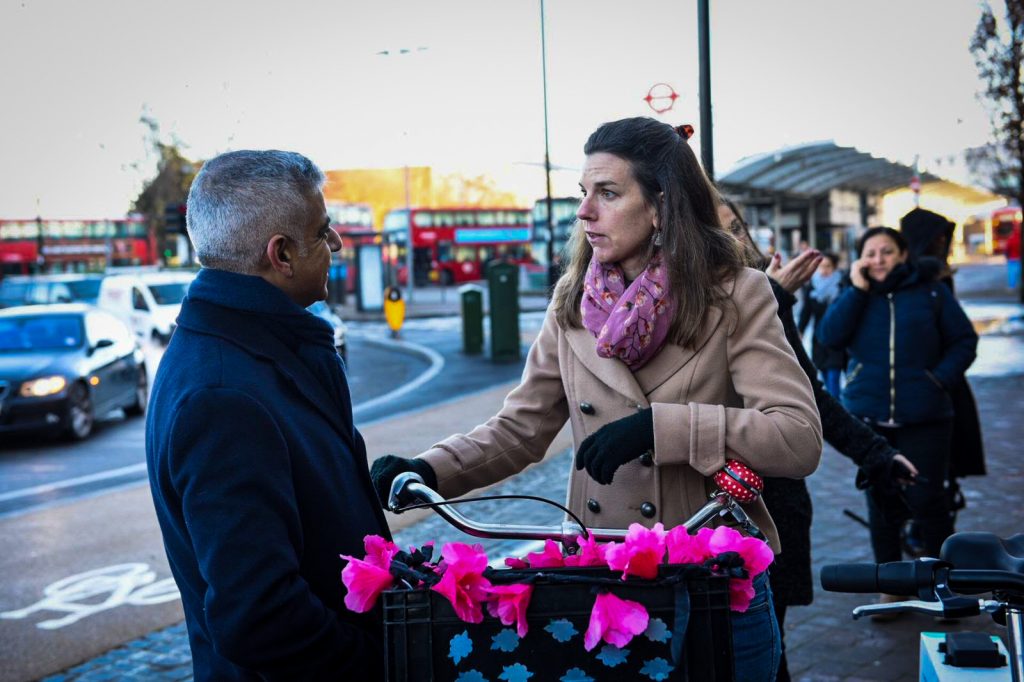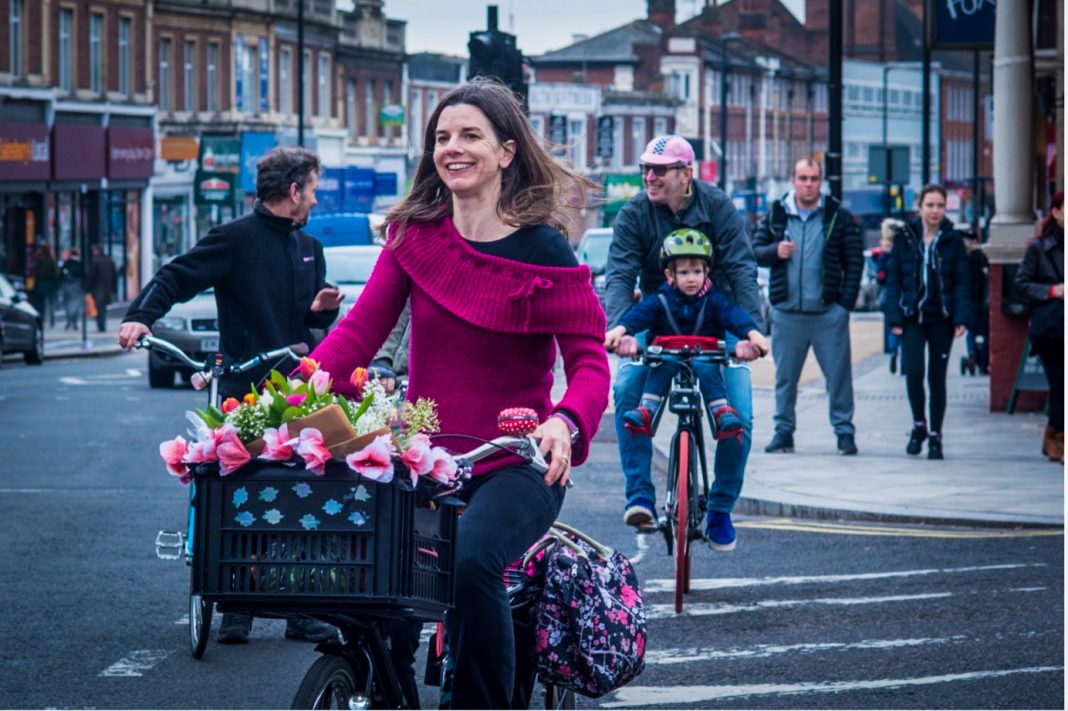After waking up one day and ‘smelling the petrol’, activist, mother, and neighbour Clare Rogers decided to turn her dream of child-friendly streets into a reality. From swapping her car for a tandem bike on the school run to getting politicians on board for low traffic neighbourhoods — Clare’s been through it all. Keep reading to learn more about her story and how she’s helping to change her neighbourhood into a ‘Mini Holland’ haven.
Clare’s Story: “I Realised We Have Cancer in Our Streets – and It’s Called Traffic”
Clare is a mother of two living in the London borough of Enfield. She has a passion for reclaiming streets from motor traffic and making them safer places for everyone to walk, cycle, and play.
But her vision wasn’t always so clear cut…
Clare used to drive a diesel Volkswagen to get around the city and transport her kids. One day she had a ‘lightbulb moment’ when she was in her car and saw smog hanging over the city skyline. “I had become totally car blind”, she said. “I realised we no longer see traffic as a problem, and this is something I had to change.”
One of the first things she did was buy a tandem bike to cycle with her kids to and from school. “No one else in their right mind would have travelled along that road with a child… they thought I was crazy – but it was my first step to getting out of my car for good.”
Back in 2014, Clare’s borough received £30 million in funding as a part of the mayor’s Healthy Streets for London approach which aimed to support Enfield in creating ‘Mini-Hollands’: a series of Dutch-style cycling infrastructure and traffic calming measures to encourage a modal shift from car to bike for short journeys.
After this, Clare became heavily involved in the project, and also started her own blog where she began to document personal stories about her journey through advocacy. Since then, she has become an organiser of Enfield’s first ‘play streets’ for children, the joint co-ordinator of the Enfield Cycling Campaign, co-founder of Better Streets for Enfield and now also works as a Healthy Streets campaigner.
One of the biggest changes to Enfield was the introduction of two low traffic neighbourhoods (LTNs) — one of which Clare now lives in. The LTN began its 6-month trial in October 2020, and the effects so far have been staggering.
Clare shared this photo to Twitter, illustrating how emotional it was for her to finally be able to see children now cycling to school along a road that was previously a hot-spot for rat-running. But what is Clare’s philosophy for other CityChangers? And what are her top tips for others who want to do make the same thing happen in their neighbourhoods?
The ‘Men in Lycra’ Sub-Species Conundrum
Clare says that one of the things that helped in her fight to push back motor traffic was removing the ‘cyclist vs motorist’ mindset. “One big strand in any successful campaign is language. We are all just people. LTNs are not about punishing you as a car driver — it’s not about classing people according to what transport they use.”
“The thing is that no-one is ‘just’ a cyclist. Everyone I know who cycles also drives —so we should steer clear of trying to categorise people into boxes. On a bigger scale, we all have the same end goal. We want our kids to have freedom, less air pollution, and more street space — so we should try and keep this in mind as our common objective.”
She highlighted one survey that shows how car drivers tend to consider cyclists as “less than human” and believe they have more of a right to occupy space. This is because cycling is now “seen as a domain of men in Lycra shorts who are not real people”, and the design of our streets greatly favours motorists.
We need to realise that ultimately, we are all fighting for the same thing and that in the end, everyone wants happier, healthier streets.
Political Will and Building Relationships With Representatives
Another element Clare said is crucial to the success of better streets is political will.
When she first joined the Enfield Cycling Campaign, Clare had to bear the brunt of a lot of initial public opposition for the Mini-Hollands scheme. However, something that helped to deal with this was having a council that was committed to the cause. “If they have willpower, they can put up with a lot of public backlash and still make the right decisions.”
Clare says it’s about establishing a working relationship with decisionmakers more than anything. “It’s not just about shouting at them and throwing stones at windows. Take your politicians on bike rides or walks around areas where LTNs already exist so they can see for themselves what it is supposed to look like.”

“You can’t overemphasise the need for a positive relationship with your councillors — really try to sit down and have a meaningful conversation and help them to understand what your goals are.”
Clare also pointed to another useful tool when it comes to politicians: polls. “Boris Johnson recently said one of the things that convinced him to push ahead with LTNs was the Department of Transport’s opinion poll which found that two-thirds of people living in and around LTNs support them.”
“It’s extremely convincing when you see the numbers — so we should push politicians to look at them.” She continued, “when you leave them to look at their email inboxes, they will hear from a lot of angry people. But when you ask them to look at the quiet majority from a neutral, professional standpoint they will be more likely to get on board.”
“When Cycling Campaigners Die, They Wake Up in Delft”: Will We Ever Be On a Par With Dutch Cities?
In her blog, Clare draws parallels with the Netherlands and how she thinks that maybe one day London and other cities at the start of their journeys can reach the same level as the Dutch when it comes to attitudes towards driving and cycling infrastructure.
“What’s encouraging is that the Dutch were totally logjammed with traffic in the 70s the way we are today. People tend to think of the Dutch as a population who ‘just like cycling’ — but this just isn’t true.”
“They also had to go through serious changes to take on traffic domination, confront motor centric attitudes and deal with strong backlash — it’s just that they’re a few decades ahead of us in doing so.”
“We have reached a point where we no longer see traffic as ‘wrong’— we have somehow put the responsibility on children to be safe on the roads rather than asking ‘why are there so many cars in my street?’ Why is it a driver’s right to cut a few seconds off their car journey more important than a child’s right to play out in their own street?”
Onwards and Upwards
But Clare feels like now could be the turning point for changing attitudes towards driving and cycling. “It feels like the stars might be aligned enough now for us to push for these kinds of changes in our neighbourhoods.”
“As LTNs become more popular people will have their eyes opened to how they actually work.” The best way to get change is to simply start doing it, one street at a time!
If you’d like to read more about Clare’s work, check out the following links:


